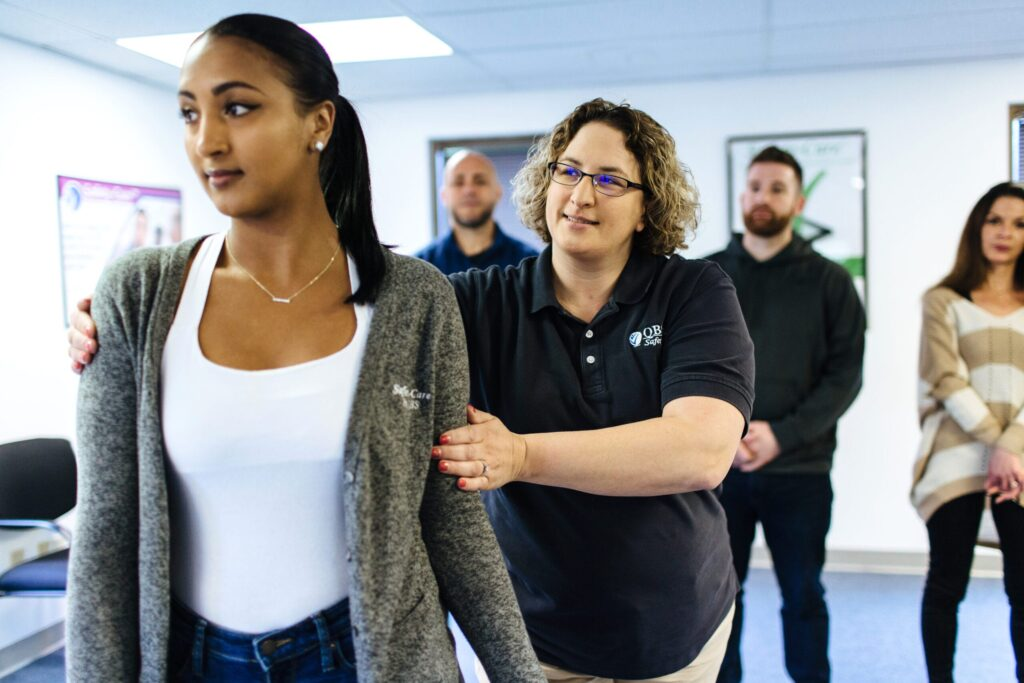Oregon Health Authority – Behavioral Health Services, Division 22: Children & Adolescents: Intensive Treatment Services; Integrated Licenses; Children’s Emergency Safety Intervention Specialists, 309-022-0175
Below is a summary of the restraint and seclusion requirements set forth by the Oregon Health Authority for facilities serving children and adolescents. Also included is information on how Safety-Care can be used as a training tool to ensure the safety of all involved parties.

.png?width=88&height=95&name=Group%20137%20(5).png)


How to Implement Safety-Care?
1. Register for a Safety-Care Trainer class or call us to request a closed session for your organization. We regularly conduct classes in all 50 states and Canada.
2. Complete your class to become a certified Safety-Care Trainer for your organization. We bring you to fluency using an errorless teaching methodology.
3. You train and certify your staff in Safety-Care’s effective techniques.
4. Our Master Trainers are available by phone, email, or video to help your organization with any questions or concerns while using or implementing Safety-Care.

Legal Requirements
|
Summary: Filed: 01-27-2023 Last Updated: December, 2024 Below is a summary of the restraint and seclusion requirements set forth by the Oregon Health Authority for facilities serving children and adolescents. Also included is information on how Safety-Care can be used as a training tool to ensure the safety of all involved parties. How Safety-Care aligns: Numerous health care organizations throughout the United States and Canada rely upon QBS and our Safety-Care training to provide their staff members with the training they need to help maintain a safe and healthy environment. Safety-Care provides a comprehensive, supportive approach to incident prevention, de-escalation, and management. Your Staff will learn practical strategies for helping students that use evidence-based practices consistent with PBIS (Positive Behavior Interventions and Supports) and ABA (Applied Behavior Analysis). |
|
Restraint and seclusion are only be used in emergency safety situations where there is an imminent risk of harm to the individual or others, such as violence, personal injury, or attempted suicide. Any use of an intervention (restraint or seclusion) must respect the dignity and civil rights of the individual and are not to be utilized as a form of punishment, discipline, or for the convenience of staff.
|
|
Physical Restraint
How Safety-Care aligns: Safety-Care can be taught to all levels of staff, from administration down to volunteers. Additionally, our core trainings can be supplemented with unique add-on trainings focused on specific needs and professions. Safety-Care uses a Train the Trainer model allowing each organization to quickly develop their own core of trainers qualified in the most current behavioral interventions and de-escalation strategies. Our Master Trainers can have up to ten (10) staff ready to train in as little as three days. Safety-Care is geared towards ensuring that all trainees are familiar with a single response system and can respond in-kind to numerous situations regardless of the professional setting.
|
| Seclusion All authorization, documentation, reporting and debriefing listed above are the same for the use of seclusion but the patient must be visually monitored continuously, and documented every 15 minutes. Individuals should also have access to regular meals, bathing, and bathrooms during seclusion. Additionally, facilities seeking authorization for seclusion rooms must be approved by the Division. This process involves submitting a written application to the Division, including a comprehensive plan for seclusion use, facility policies and procedures, staff training records, and quality assessment practices. The Division will review the application and conduct a facility review, ensuring compliance with all requirements. Upon approval, the chief officer will certify the facility, effective for a maximum of three years, with the option for renewal. Seclusion rooms must meet specific structural and physical requirements in order to meet authorization.
|
Why Safety-Care?
Benefits & Differentiators
In addition to Safety-Care being highly cost-effective, you get:

Skills to effectively prevent, minimize, & manage behavioral challenges with dignity, safety, & the possibility of change

Decreases in staff and patient injuries and reduction in restraint & seclusion time

Instructional procedures based on decades of evidence-based research & compatible with ABA, PBIS & reinforcement-based environments

Customizable program for your setting, staff & clientele, with a strong focus on preventative via non-intrusive, replacement behaviors

Extremely rigorous standards grounded in errorless teaching methodology

Small, intimate class sizes backed by unlimited support & resources
How Is Safety-Care So Effective?
A Genuine Focus on Implementing & Managing Positive Behavioral Skills
Proactive, environmental management recommendations
Understanding of evocative effects of staff behavior
In-depth analysis of antecedents and proactive antecedent interventions
Evidence-based reinforcement procedures
Required competency in de-escalation skills
Humane, non-invasive touch and QBS Check™ strategies
Evidence-based teaching procedures
Applicable to a wide array of settings, conditions & challenging behavior





